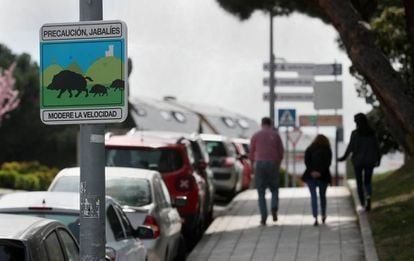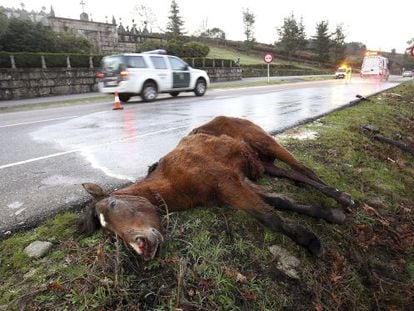Spain’s invasion of the wild boars
Madrid town of Torrelodones has launched a porcine awareness campaign for residents

“Caution, wild boar. Slow down”, says a new sign that has gone up on the streets of Torrelodones, a dormitory town 29 kilometers northwest of Madrid. In recent years, the wild boar have become so numerous that they now venture into town and can be seen crossing the A6 highway by the bridge along with the other local residents.

Torrelodones is not the only town to have got used to living cheek by jowl with these wild beasts that have taken to camping out in town centers around Madrid. “It’s becoming common in the region,” says a spokesman from the regional government's environment department, who points out, in the absence of a census, that the captures of the animal soared by 25% in one season, from 4,205 in 2014 to 5,267 in 2015.
Las Rozas, Colmenar Viejo, Tres Cantos, San Sebastián de los Reyes and Alcalá de Henares are just some of the towns dealing with this problem. And the respect that usually exists between these animals and humans is breaking down as the boar get cheekier, an attitude exacerbated by the fact that some residents insist on feeding them.
The respect that usually exists between these animals and humans is breaking down as the boars get cheekier
“This is a big mistake,” says Santiago Fernández, Counselor for the Environment in Torrelodones. “It means they get used to people, lose their fear and encroach increasingly on urban areas.”
Fernández knows what he is talking about as he can now count a family of wild boar among his neighbors – a mother and three piglets who are growing up fast. “I suppose that soon I will get to know their children,” he says.
The main concern, according to the Torrelodones Council, is the risk the wild boar pose to road safety: a campaign has been launched to raise awareness among drivers. There is also a pamphlet advising locals about what to do when confronted with the pigs, which are to be counted by the council as part of the campaign. Their movements will also be tracked.
When Torrelodones Council tried to enlist the support of the Community of Madrid, the regional government made it clear that the pigs are the town’s responsibility. According to Fernández, who says they have been asking for regional government assistance for the past five years, this does not appear to square up with hunting laws.
However, the regional environment department explains that when it comes to urban areas, these animals have to be controlled by the towns themselves. All the regional authorities can do is issue licenses allowing the animals to be trapped in cages and, in exceptional circumstances – in collaboration with the Hunting Federation and with the local counsel’s assent – issue licenses allowing them to be hunted with weapons such as bows and arrows.
In 2014, Madrid’s regional government authorized 507 of these exceptional licenses – 40% more than in 2010 – in different areas of the Community of Madrid, particularly the dormitory towns to the north of the capital.
Las Rozas Town Council says that the animals use the town’s green zones as corridors
In San Sebastián de los Reyes, wild boar are definitely a problem, particularly in breeding season. They turn up in the Dehesa Boyal area and the Monte Pesadilla, and some that have drifted toward the town of Colmenar Viejo. The same thing is happening in Las Rozas. One local complains that he can't take his dog out for a walk around the Encinar de Las Rozas park first thing in the morning or last thing at night in case he is confronted by wild boar. “It's scary because the place is full of them and they could be dangerous, especially for the dog,” he says.
Las Rozas Town Council says the animals use the town’s green zones as corridors, which means they start encroaching on urban areas. But the town has developed a program for managing the problem, which has been authorized by the Community of Madrid.
Fearless
In Las Rozas, there are even more than the average 6-12 wild boar per km2 because the animals are not afraid to wander into built-up areas in search of water and food. And as there is a dearth of natural predators, the population is growing at a rate of one or two litter a year for each female, with three to four piglets a litter.
Now the council has taken measures to keep the beasts at bay by erecting a hunting fence around at least two thirds of the area where most can be found. And on the gates in the fence, they have posted specific instructions to keep them closed.
But, as the local authorities themselves have found, fencing off the countryside is a complicated business. So what is the next step? According to the Torrelodones Council, the first step is to recognize the problem. The second is to acknowledge that wild boar are wild and unpredictable when challenged. Needless to say, they should not be approached, and dogs should be kept away from them while cars need to slow down in areas they are likely to roam. And finally, it is imperative not to dump waste that will attract them or feed them as you might a stray cat or dog.
English version by Heather Galloway.












































